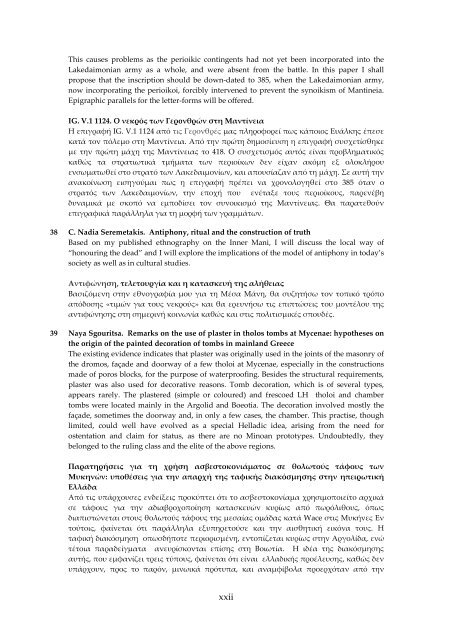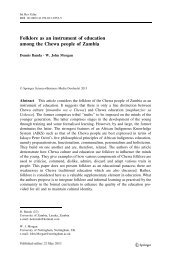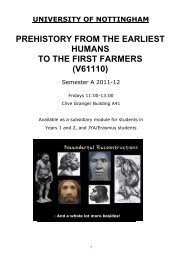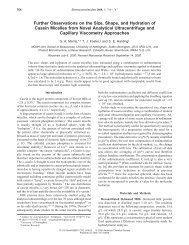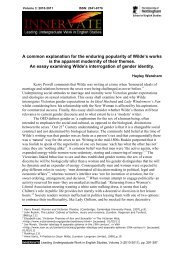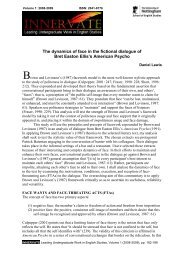Honouring the Dead in the Peloponnese - University of Nottingham
Honouring the Dead in the Peloponnese - University of Nottingham
Honouring the Dead in the Peloponnese - University of Nottingham
Create successful ePaper yourself
Turn your PDF publications into a flip-book with our unique Google optimized e-Paper software.
This causes problems as <strong>the</strong> perioikic cont<strong>in</strong>gents had not yet been <strong>in</strong>corporated <strong>in</strong>to <strong>the</strong><br />
Lakedaimonian army as a whole, and were absent from <strong>the</strong> battle. In this paper I shall<br />
propose that <strong>the</strong> <strong>in</strong>scription should be down-dated to 385, when <strong>the</strong> Lakedaimonian army,<br />
now <strong>in</strong>corporat<strong>in</strong>g <strong>the</strong> perioikoi, forcibly <strong>in</strong>tervened to prevent <strong>the</strong> synoikism <strong>of</strong> Mant<strong>in</strong>eia.<br />
Epigraphic parallels for <strong>the</strong> letter-forms will be <strong>of</strong>fered.<br />
IG. V.1 1124. Ο νεκρός των Γερoνθρών στη Μαντίνεια<br />
Η επιγραφή IG. V.1 1124 από τις Γερονθρές μας πληροφορεί πως κάποιος Ευάλκης έπεσε<br />
κατά τον πόλεμο στη Μαντίνεια. Από την πρώτη δημοσίευση η επιγραφή συσχετίσθηκε<br />
με την πρώτη μάχη της Μαντίνειας το 418. Ο συσχετισμός αυτός είναι προβληματικός<br />
καθώς τα στρατιωτικά τμήματα των περιοίκων δεν είχαν ακόμη εξ ολοκλήρου<br />
ενσωματωθεί στο στρατό των Λακεδαιμονίων, και απουσίαζαν από τη μάχη. Σε αυτή την<br />
ανακοίνωση εισηγούμαι πως η επιγραφή πρέπει να χρονολογηθεί στο 385 όταν ο<br />
στρατός των Λακεδαιμονίων, την εποχή που ενέταξε τους περιοίκους, παρενέβη<br />
δυναμικά με σκοπό να εμποδίσει τον συνοικισμό της Μαντίνειας. Θα παρατεθούν<br />
επιγραφικά παράλληλα για τη μορφή των γραμμάτων.<br />
38 C. Nadia Seremetakis. Antiphony, ritual and <strong>the</strong> construction <strong>of</strong> truth<br />
Based on my published ethnography on <strong>the</strong> Inner Mani, I will discuss <strong>the</strong> local way <strong>of</strong><br />
“honour<strong>in</strong>g <strong>the</strong> dead” and I will explore <strong>the</strong> implications <strong>of</strong> <strong>the</strong> model <strong>of</strong> antiphony <strong>in</strong> today’s<br />
society as well as <strong>in</strong> cultural studies.<br />
Αντιφώνηση, τελετουργία και η κατασκευή της αλήθειας<br />
Βασιζόμενη στην εθνογραφία μου για τη Μέσα Μάνη, θα συζητήσω τον τοπικό τρόπο<br />
απόδοσης «τιμών για τους νεκρούς» και θα ερευνήσω τις επιπτώσεις του μοντέλου της<br />
αντιφώνησης στη σημερινή κοινωνία καθώς και στις πολιτισμικές σπουδές.<br />
39 Naya Sgouritsa. Remarks on <strong>the</strong> use <strong>of</strong> plaster <strong>in</strong> tholos tombs at Mycenae: hypo<strong>the</strong>ses on<br />
<strong>the</strong> orig<strong>in</strong> <strong>of</strong> <strong>the</strong> pa<strong>in</strong>ted decoration <strong>of</strong> tombs <strong>in</strong> ma<strong>in</strong>land Greece<br />
The exist<strong>in</strong>g evidence <strong>in</strong>dicates that plaster was orig<strong>in</strong>ally used <strong>in</strong> <strong>the</strong> jo<strong>in</strong>ts <strong>of</strong> <strong>the</strong> masonry <strong>of</strong><br />
<strong>the</strong> dromos, façade and doorway <strong>of</strong> a few tholoi at Mycenae, especially <strong>in</strong> <strong>the</strong> constructions<br />
made <strong>of</strong> poros blocks, for <strong>the</strong> purpose <strong>of</strong> waterpro<strong>of</strong><strong>in</strong>g. Besides <strong>the</strong> structural requirements,<br />
plaster was also used for decorative reasons. Tomb decoration, which is <strong>of</strong> several types,<br />
appears rarely. The plastered (simple or coloured) and frescoed LH tholoi and chamber<br />
tombs were located ma<strong>in</strong>ly <strong>in</strong> <strong>the</strong> Argolid and Boeotia. The decoration <strong>in</strong>volved mostly <strong>the</strong><br />
façade, sometimes <strong>the</strong> doorway and, <strong>in</strong> only a few cases, <strong>the</strong> chamber. Τhis practise, though<br />
limited, could well have evolved as a special Helladic idea, aris<strong>in</strong>g from <strong>the</strong> need for<br />
ostentation and claim for status, as <strong>the</strong>re are no M<strong>in</strong>oan prototypes. Undoubtedly, <strong>the</strong>y<br />
belonged to <strong>the</strong> rul<strong>in</strong>g class and <strong>the</strong> elite <strong>of</strong> <strong>the</strong> above regions.<br />
Παρατηρήσεις για τη χρήση ασβεστοκονιάματος σε θολωτούς τάφους των<br />
Μυκηνών: υποθέσεις για την απαρχή της ταφικής διακόσμησης στην ηπειρωτική<br />
Ελλάδα<br />
Από τις υπάρχουσες ενδείξεις προκύπτει ότι το ασβεστοκονίαμα χρησιμοποιείτο αρχικά<br />
σε τάφους για την αδιαβροχοποίηση κατασκευών κυρίως από πωρόλιθους, όπως<br />
διαπιστώνεται στους θολωτούς τάφους της μεσαίας ομάδας κατά Wace στις Μυκήνες Εν<br />
τούτοις, φαίνεται ότι παράλληλα εξυπηρετούσε και την αισθητική εικόνα τους. Η<br />
ταφική διακόσμηση οπωσδήποτε περιορισμένη, εντοπίζεται κυρίως στην Αργολίδα, ενώ<br />
τέτοια παραδείγματα ανευρίσκονται επίσης στη Βοιωτία. Η ιδέα της διακόσμησης<br />
αυτής, που εμφανίζει τρεις τύπους, φαίνεται ότι είναι ελλαδικής προέλευσης, καθώς δεν<br />
υπάρχουν, προς το παρόν, μινωικά πρότυπα, και αναμφίβολα προερχόταν από την<br />
xxii


